Xinyuan Zhang
AttFC: Attention Fully-Connected Layer for Large-Scale Face Recognition with One GPU
Mar 10, 2025Abstract:Nowadays, with the advancement of deep neural networks (DNNs) and the availability of large-scale datasets, the face recognition (FR) model has achieved exceptional performance. However, since the parameter magnitude of the fully connected (FC) layer directly depends on the number of identities in the dataset. If training the FR model on large-scale datasets, the size of the model parameter will be excessively huge, leading to substantial demand for computational resources, such as time and memory. This paper proposes the attention fully connected (AttFC) layer, which could significantly reduce computational resources. AttFC employs an attention loader to generate the generative class center (GCC), and dynamically store the class center with Dynamic Class Container (DCC). DCC only stores a small subset of all class centers in FC, thus its parameter count is substantially less than the FC layer. Also, training face recognition models on large-scale datasets with one GPU often encounter out-of-memory (OOM) issues. AttFC overcomes this and achieves comparable performance to state-of-the-art methods.
MSConv: Multiplicative and Subtractive Convolution for Face Recognition
Mar 08, 2025Abstract:In Neural Networks, there are various methods of feature fusion. Different strategies can significantly affect the effectiveness of feature representation, consequently influencing the ability of model to extract representative and discriminative features. In the field of face recognition, traditional feature fusion methods include feature concatenation and feature addition. Recently, various attention mechanism-based fusion strategies have emerged. However, we found that these methods primarily focus on the important features in the image, referred to as salient features in this paper, while neglecting another equally important set of features for image recognition tasks, which we term differential features. This may cause the model to overlook critical local differences when dealing with complex facial samples. Therefore, in this paper, we propose an efficient convolution module called MSConv (Multiplicative and Subtractive Convolution), designed to balance the learning of model about salient and differential features. Specifically, we employ multi-scale mixed convolution to capture both local and broader contextual information from face images, and then utilize Multiplication Operation (MO) and Subtraction Operation (SO) to extract salient and differential features, respectively. Experimental results demonstrate that by integrating both salient and differential features, MSConv outperforms models that only focus on salient features.
Deep Learning-Based Diffusion MRI Tractography: Integrating Spatial and Anatomical Information
Mar 05, 2025Abstract:Diffusion MRI tractography technique enables non-invasive visualization of the white matter pathways in the brain. It plays a crucial role in neuroscience and clinical fields by facilitating the study of brain connectivity and neurological disorders. However, the accuracy of reconstructed tractograms has been a longstanding challenge. Recently, deep learning methods have been applied to improve tractograms for better white matter coverage, but often comes at the expense of generating excessive false-positive connections. This is largely due to their reliance on local information to predict long range streamlines. To improve the accuracy of streamline propagation predictions, we introduce a novel deep learning framework that integrates image-domain spatial information and anatomical information along tracts, with the former extracted through convolutional layers and the later modeled via a Transformer-decoder. Additionally, we employ a weighted loss function to address fiber class imbalance encountered during training. We evaluate the proposed method on the simulated ISMRM 2015 Tractography Challenge dataset, achieving a valid streamline rate of 66.2%, white matter coverage of 63.8%, and successfully reconstructing 24 out of 25 bundles. Furthermore, on the multi-site Tractoinferno dataset, the proposed method demonstrates its ability to handle various diffusion MRI acquisition schemes, achieving a 5.7% increase in white matter coverage and a 4.1% decrease in overreach compared to RNN-based methods.
RVAFM: Re-parameterizing Vertical Attention Fusion Module for Handwritten Paragraph Text Recognition
Mar 05, 2025



Abstract:Handwritten Paragraph Text Recognition (HPTR) is a challenging task in Computer Vision, requiring the transformation of a paragraph text image, rich in handwritten text, into text encoding sequences. One of the most advanced models for this task is Vertical Attention Network (VAN), which utilizes a Vertical Attention Module (VAM) to implicitly segment paragraph text images into text lines, thereby reducing the difficulty of the recognition task. However, from a network structure perspective, VAM is a single-branch module, which is less effective in learning compared to multi-branch modules. In this paper, we propose a new module, named Re-parameterizing Vertical Attention Fusion Module (RVAFM), which incorporates structural re-parameterization techniques. RVAFM decouples the structure of the module during training and inference stages. During training, it uses a multi-branch structure for more effective learning, and during inference, it uses a single-branch structure for faster processing. The features learned by the multi-branch structure are fused into the single-branch structure through a special fusion method named Re-parameterization Fusion (RF) without any loss of information. As a result, we achieve a Character Error Rate (CER) of 4.44% and a Word Error Rate (WER) of 14.37% on the IAM paragraph-level test set. Additionally, the inference speed is slightly faster than VAN.
Reliable Deep Diffusion Tensor Estimation: Rethinking the Power of Data-Driven Optimization Routine
Sep 04, 2024Abstract:Diffusion tensor imaging (DTI) holds significant importance in clinical diagnosis and neuroscience research. However, conventional model-based fitting methods often suffer from sensitivity to noise, leading to decreased accuracy in estimating DTI parameters. While traditional data-driven deep learning methods have shown potential in terms of accuracy and efficiency, their limited generalization to out-of-training-distribution data impedes their broader application due to the diverse scan protocols used across centers, scanners, and studies. This work aims to tackle these challenges and promote the use of DTI by introducing a data-driven optimization-based method termed DoDTI. DoDTI combines the weighted linear least squares fitting algorithm and regularization by denoising technique. The former fits DW images from diverse acquisition settings into diffusion tensor field, while the latter applies a deep learning-based denoiser to regularize the diffusion tensor field instead of the DW images, which is free from the limitation of fixed-channel assignment of the network. The optimization object is solved using the alternating direction method of multipliers and then unrolled to construct a deep neural network, leveraging a data-driven strategy to learn network parameters. Extensive validation experiments are conducted utilizing both internally simulated datasets and externally obtained in-vivo datasets. The results, encompassing both qualitative and quantitative analyses, showcase that the proposed method attains state-of-the-art performance in DTI parameter estimation. Notably, it demonstrates superior generalization, accuracy, and efficiency, rendering it highly reliable for widespread application in the field.
Continuous-Time Digital Twin with Analogue Memristive Neural Ordinary Differential Equation Solver
Jun 12, 2024Abstract:Digital twins, the cornerstone of Industry 4.0, replicate real-world entities through computer models, revolutionising fields such as manufacturing management and industrial automation. Recent advances in machine learning provide data-driven methods for developing digital twins using discrete-time data and finite-depth models on digital computers. However, this approach fails to capture the underlying continuous dynamics and struggles with modelling complex system behaviour. Additionally, the architecture of digital computers, with separate storage and processing units, necessitates frequent data transfers and Analogue-Digital (A/D) conversion, thereby significantly increasing both time and energy costs. Here, we introduce a memristive neural ordinary differential equation (ODE) solver for digital twins, which is capable of capturing continuous-time dynamics and facilitates the modelling of complex systems using an infinite-depth model. By integrating storage and computation within analogue memristor arrays, we circumvent the von Neumann bottleneck, thus enhancing both speed and energy efficiency. We experimentally validate our approach by developing a digital twin of the HP memristor, which accurately extrapolates its nonlinear dynamics, achieving a 4.2-fold projected speedup and a 41.4-fold projected decrease in energy consumption compared to state-of-the-art digital hardware, while maintaining an acceptable error margin. Additionally, we demonstrate scalability through experimentally grounded simulations of Lorenz96 dynamics, exhibiting projected performance improvements of 12.6-fold in speed and 189.7-fold in energy efficiency relative to traditional digital approaches. By harnessing the capabilities of fully analogue computing, our breakthrough accelerates the development of digital twins, offering an efficient and rapid solution to meet the demands of Industry 4.0.
Edge Intelligence Optimization for Large Language Model Inference with Batching and Quantization
May 12, 2024Abstract:Generative Artificial Intelligence (GAI) is taking the world by storm with its unparalleled content creation ability. Large Language Models (LLMs) are at the forefront of this movement. However, the significant resource demands of LLMs often require cloud hosting, which raises issues regarding privacy, latency, and usage limitations. Although edge intelligence has long been utilized to solve these challenges by enabling real-time AI computation on ubiquitous edge resources close to data sources, most research has focused on traditional AI models and has left a gap in addressing the unique characteristics of LLM inference, such as considerable model size, auto-regressive processes, and self-attention mechanisms. In this paper, we present an edge intelligence optimization problem tailored for LLM inference. Specifically, with the deployment of the batching technique and model quantization on resource-limited edge devices, we formulate an inference model for transformer decoder-based LLMs. Furthermore, our approach aims to maximize the inference throughput via batch scheduling and joint allocation of communication and computation resources, while also considering edge resource constraints and varying user requirements of latency and accuracy. To address this NP-hard problem, we develop an optimal Depth-First Tree-Searching algorithm with online tree-Pruning (DFTSP) that operates within a feasible time complexity. Simulation results indicate that DFTSP surpasses other batching benchmarks in throughput across diverse user settings and quantization techniques, and it reduces time complexity by over 45% compared to the brute-force searching method.
MHLR: Moving Haar Learning Rate Scheduler for Large-scale Face Recognition Training with One GPU
Apr 17, 2024Abstract:Face recognition (FR) has seen significant advancements due to the utilization of large-scale datasets. Training deep FR models on large-scale datasets with multiple GPUs is now a common practice. In fact, computing power has evolved into a foundational and indispensable resource in the area of deep learning. It is nearly impossible to train a deep FR model without holding adequate hardware resources. Recognizing this challenge, some FR approaches have started exploring ways to reduce the time complexity of the fully-connected layer in FR models. Unlike other approaches, this paper introduces a simple yet highly effective approach, Moving Haar Learning Rate (MHLR) scheduler, for scheduling the learning rate promptly and accurately in the training process. MHLR supports large-scale FR training with only one GPU, which is able to accelerate the model to 1/4 of its original training time without sacrificing more than 1% accuracy. More specifically, MHLR only needs $30$ hours to train the model ResNet100 on the dataset WebFace12M containing more than 12M face images with 0.6M identities. Extensive experiments validate the efficiency and effectiveness of MHLR.
Efficient and accurate neural field reconstruction using resistive memory
Apr 15, 2024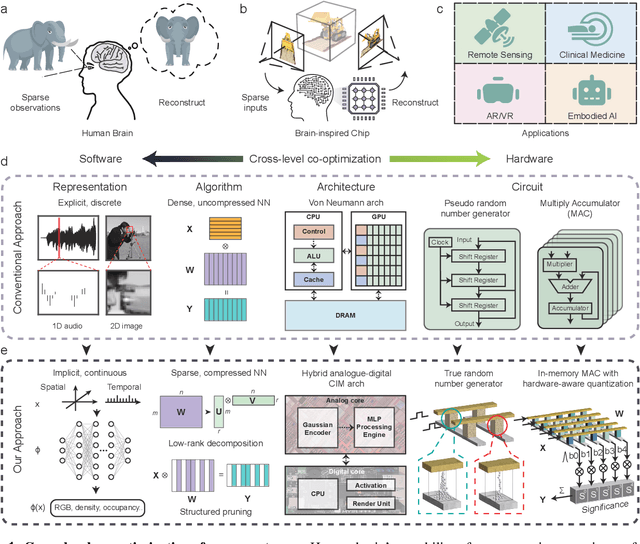
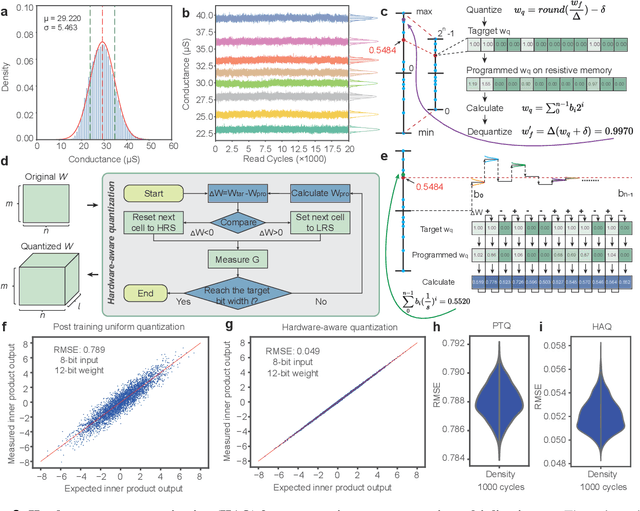
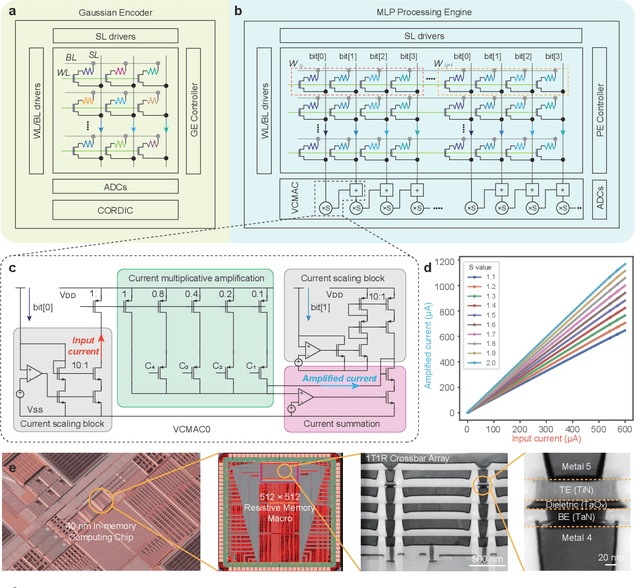
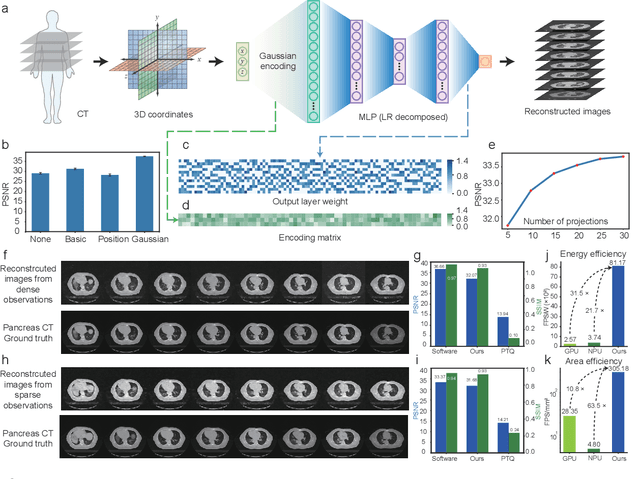
Abstract:Human beings construct perception of space by integrating sparse observations into massively interconnected synapses and neurons, offering a superior parallelism and efficiency. Replicating this capability in AI finds wide applications in medical imaging, AR/VR, and embodied AI, where input data is often sparse and computing resources are limited. However, traditional signal reconstruction methods on digital computers face both software and hardware challenges. On the software front, difficulties arise from storage inefficiencies in conventional explicit signal representation. Hardware obstacles include the von Neumann bottleneck, which limits data transfer between the CPU and memory, and the limitations of CMOS circuits in supporting parallel processing. We propose a systematic approach with software-hardware co-optimizations for signal reconstruction from sparse inputs. Software-wise, we employ neural field to implicitly represent signals via neural networks, which is further compressed using low-rank decomposition and structured pruning. Hardware-wise, we design a resistive memory-based computing-in-memory (CIM) platform, featuring a Gaussian Encoder (GE) and an MLP Processing Engine (PE). The GE harnesses the intrinsic stochasticity of resistive memory for efficient input encoding, while the PE achieves precise weight mapping through a Hardware-Aware Quantization (HAQ) circuit. We demonstrate the system's efficacy on a 40nm 256Kb resistive memory-based in-memory computing macro, achieving huge energy efficiency and parallelism improvements without compromising reconstruction quality in tasks like 3D CT sparse reconstruction, novel view synthesis, and novel view synthesis for dynamic scenes. This work advances the AI-driven signal restoration technology and paves the way for future efficient and robust medical AI and 3D vision applications.
Resistive Memory-based Neural Differential Equation Solver for Score-based Diffusion Model
Apr 08, 2024
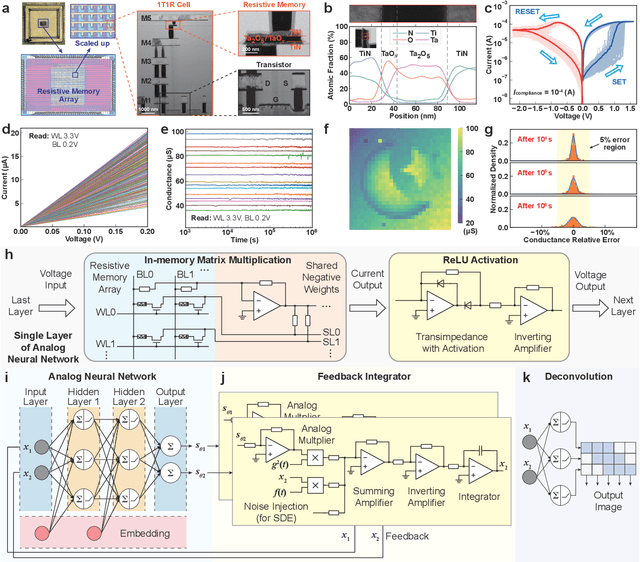
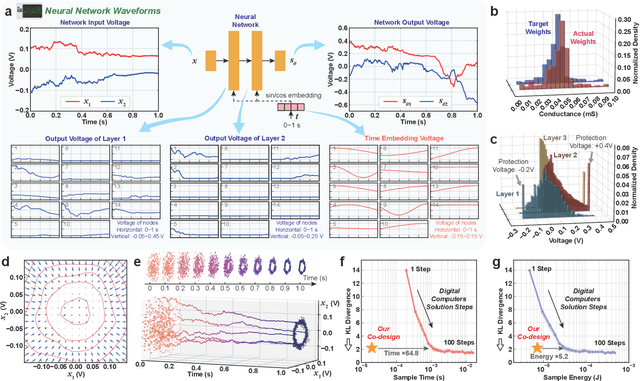
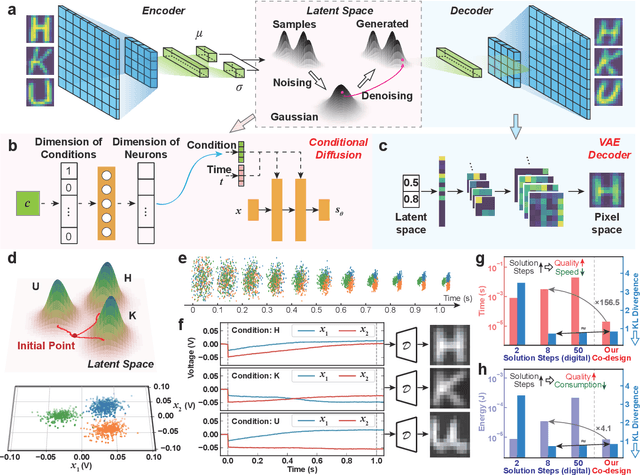
Abstract:Human brains image complicated scenes when reading a novel. Replicating this imagination is one of the ultimate goals of AI-Generated Content (AIGC). However, current AIGC methods, such as score-based diffusion, are still deficient in terms of rapidity and efficiency. This deficiency is rooted in the difference between the brain and digital computers. Digital computers have physically separated storage and processing units, resulting in frequent data transfers during iterative calculations, incurring large time and energy overheads. This issue is further intensified by the conversion of inherently continuous and analog generation dynamics, which can be formulated by neural differential equations, into discrete and digital operations. Inspired by the brain, we propose a time-continuous and analog in-memory neural differential equation solver for score-based diffusion, employing emerging resistive memory. The integration of storage and computation within resistive memory synapses surmount the von Neumann bottleneck, benefiting the generative speed and energy efficiency. The closed-loop feedback integrator is time-continuous, analog, and compact, physically implementing an infinite-depth neural network. Moreover, the software-hardware co-design is intrinsically robust to analog noise. We experimentally validate our solution with 180 nm resistive memory in-memory computing macros. Demonstrating equivalent generative quality to the software baseline, our system achieved remarkable enhancements in generative speed for both unconditional and conditional generation tasks, by factors of 64.8 and 156.5, respectively. Moreover, it accomplished reductions in energy consumption by factors of 5.2 and 4.1. Our approach heralds a new horizon for hardware solutions in edge computing for generative AI applications.
 Add to Chrome
Add to Chrome Add to Firefox
Add to Firefox Add to Edge
Add to Edge